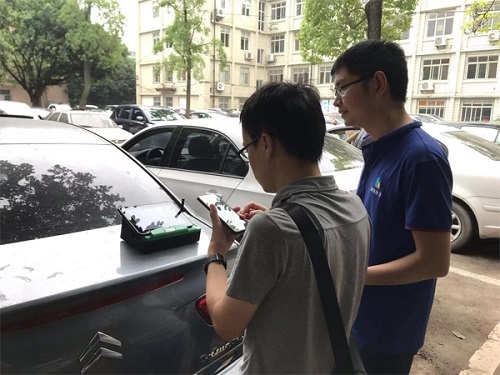How to Measure Particles on The Road
Palas® Fidas® Frog assists environmental departments in measuring particulate matter data.
Fine dust particles caused by industrial pollution, automobile exhaust, and the like are ubiquitous. State authorities, institutions, and of course, companies need to tackle this challenge. Against this background, Sichuan Moxian Technology Co., Ltd. decided to choose the Palas® Fidas® Frog Fine Dust Measurement Device to monitor particulate matter data for government environmental protection departments. Fidas® Frog displayed an outstanding performance in this project.

Portable measurement with high accuracy of data monitoring
Sichuan Moxian Technology Co., Ltd. is an expert in the field of environmental quality monitoring and analysis. The company focuses on providing customers with total solutions and services for ambient air quality, online continuous monitoring of motor vehicle exhaust and pollution sources, walk-away monitoring, real-time monitoring of harmful gases in plants, and other related instruments in many fields. In this project, which was conducted in cooperation with the government environmental protection departments, Sichuan Moxian Technology used Palas® Fidas® Frog as the core monitoring instrument mounted on a car to measure particles in the city.

Conventional devices could not deliver light scattering emission data with the required accuracy. These devices were also unsatisfactory for mobile use. This is why the Fidas® Frog was the first choice. This fine dust measurement device is small, which is ideal for mobile use. In addition, the Fidas® Frog ensures highly accurate measurement results.
Excellent mobile monitoring
A significant advantage for this project is the lightweight and compact design of the Fidas® Frog. This equipment can collect reliable data quickly and efficiently at the same time. To test the performance of the Fidas® Frog, the researchers chose a construction site located in an industrial park in which particles should be measured. The researchers controlled the Fidas® Frog via a detachable tablet, enabling them to monitor remotely at any time. Fidas® Frog is easy to use, and only a few parameters were used during the measuring process. The users quickly learned how to use the functions for documentation and further processing of the measurement data.

The large trucks moving in and out of the constructions site of the industrial park caused traffic jams and thus a vast amount of fine dust during the measuring period. This effect could be monitored and documented with the help of the Fidas® Frog. The changes of various particles in the ambient air can be easily detected and displayed, proving the accuracy of the measured data. The sensitivity, accuracy, and mobility of the Fidas® Frog during the measurement process left a deep impression on the customer.

Measuring fine dust made easy
Fidas® Frog allows a fast, dependable, and quality-assured monitoring of fine dust within the scope of Health, Safety and Environment (HSE) management at workplaces or in the range of indoor air quality measurements, such as offices or public-school buildings. Fidas® Frog simultaneously measures the environmentally relevant mass fractions PM1, PM2.5, PM4, PM10, TSP, and the particle number and the particle size distribution within the particle size range of 0.18 – 100 µm. By providing fine dust with high time resolution, the operator receives comprehensive information for evaluation and assessment of the fine dust pollution for the investigated application. The compact and light design of the Fidas® Frog and the operation time of up to 8 hours per battery charge ensures a flexible application.
Palas® Fidas® Frog Fine Dust Measurement Device

Advantages:
l Continuous and simultaneous real-time measurement of PM1, PM2.5, PM10 and TSP-values
l Additional particle number concentration and particle size distribution
l Wide measuring range: 180 nm – 100 µm
l Adjustable time resolution from 1s
l Direct comparison of different measurements
l Configuration of limit values possible
l High quality of measuring data through implementation of the sensor / evaluation algorithm of EN certified Fidas® 200
l Additional expanded range of applications by possible separation of the measuring device and the Tablet-PC for control (communication via WLAN)
l Up to eight hours of measurement time in battery mode
l Ergonomic design and low weight
l Intuitive and simple operation
l Integrated camera for documentation of the measurement
l Export function for measured data
l Possibility to generate a measurement report as pdf in Fidas® Frog
l Remote monitoring and control via network integration easily possible
Applications:
l Fine dust monitoring at alternating locations or in movement
l Air quality monitoring indoors, at the workplace, or inside vehicles
l Use as an aerosol spectrometer in setups where space is limited
Palas® China will arrange a series of online webinars both in English and Chinese for Ambient air quality continuous monitoring system, Palas SMPS scanning mobility particle sizer, Palas Promo & Aerosol Generator & Dilution system, ISO 16890 filter media tester, Palas MFP 3000 G, ISO 29463-3 filter media tester, Palas MFP Nano plus 4000, ISO 17536 Fractional filtration efficiency tester of Oil Mist Separator, Palas HMT 1000, as well as Particle Distribution Measurement Devices Introduction - Optical Scattering Method and many other solutions. If interested in the webinars for our products, you are more than welcome to register on our official website and get the latest webinar plan!
Register online now to participate in our webinars if interested (Link: https://palas.com.cn/contact-us/).
|
Date
|
Day of week
|
Time
|
Topic
|
|
2021/10/19
|
Tuesday
|
13:30 - 15:00
|
How to Perform Fractional Filtration Efficiency Test on Oil Mist Separator in accordance with ISO 17536?
|
|
2021/11/2
|
Tuesday
|
13:30 - 15:00
|
MFP series filter media tester webinar "Basics"
|
|
2021/11/9
|
Tuesday
|
13:30 - 15:00
|
Particle Distribution Measurement Devices Introduction - Optical Scattering Method
|